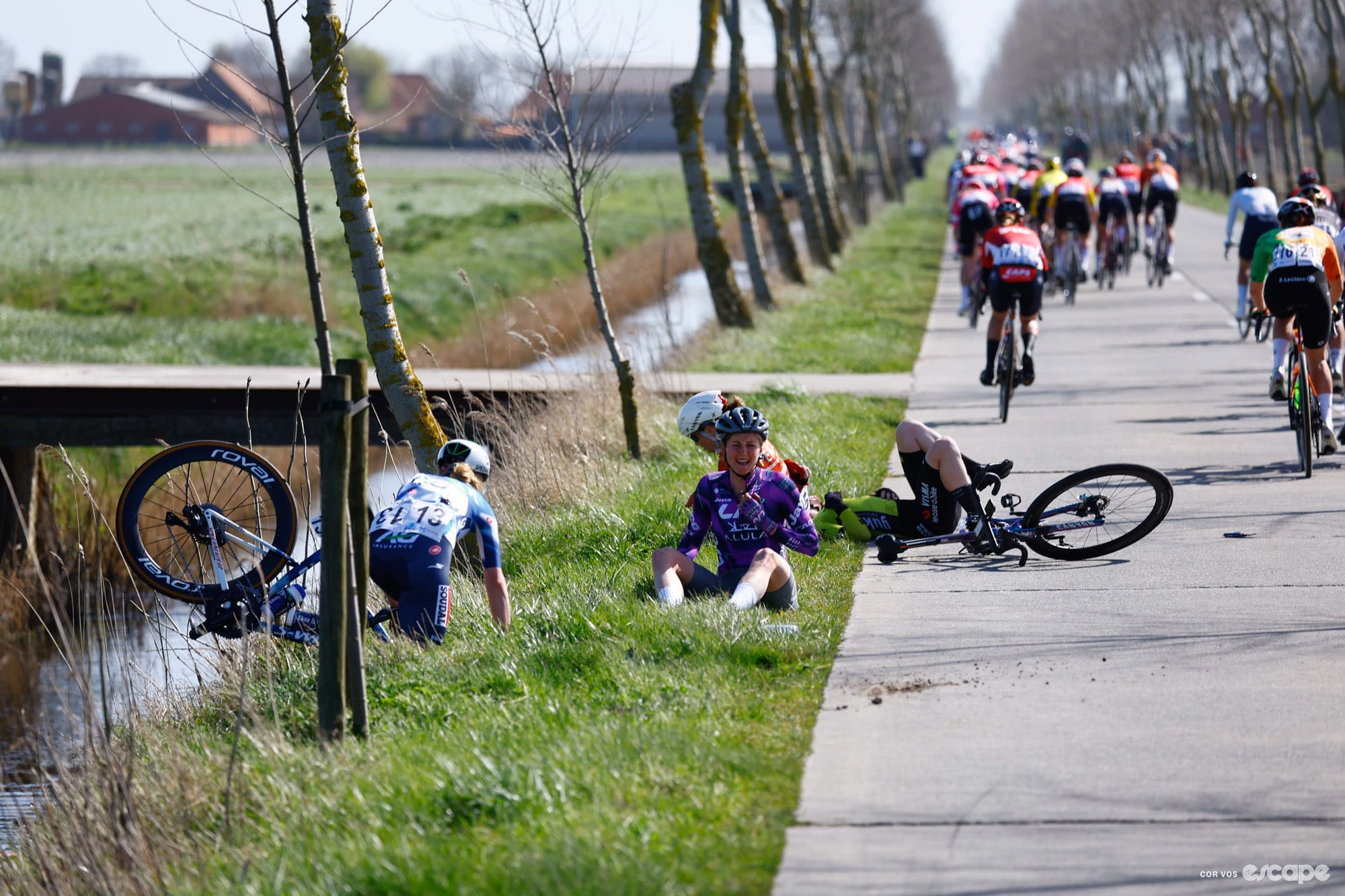Decades before Tadej Pogačar was setting cycling ablaze with daring and dominant solo raids from distance, Bernard Hinault was doing the same in arguably more dramatic and impressive circumstances. This is not to suggest that either our present day Cannibal nor ‘the Badger’ were the first or only of a certain kind of bold – or foolhardy – rider, but in our modern era of extraordinary dominance, it’s worth reminding ourselves that we’ve seen it all before.
A perfect example of this is the 1980 edition of Liège-Bastogne-Liège, the 66th running of ‘La Doyenne’ (the old lady), the oldest of cycling’s five Monuments. Images of this race are well circulated – you might have seen them without knowing what you were looking at – but what actually happened in the race? What led to Hinault's huge winning margin? And why did so few finish?
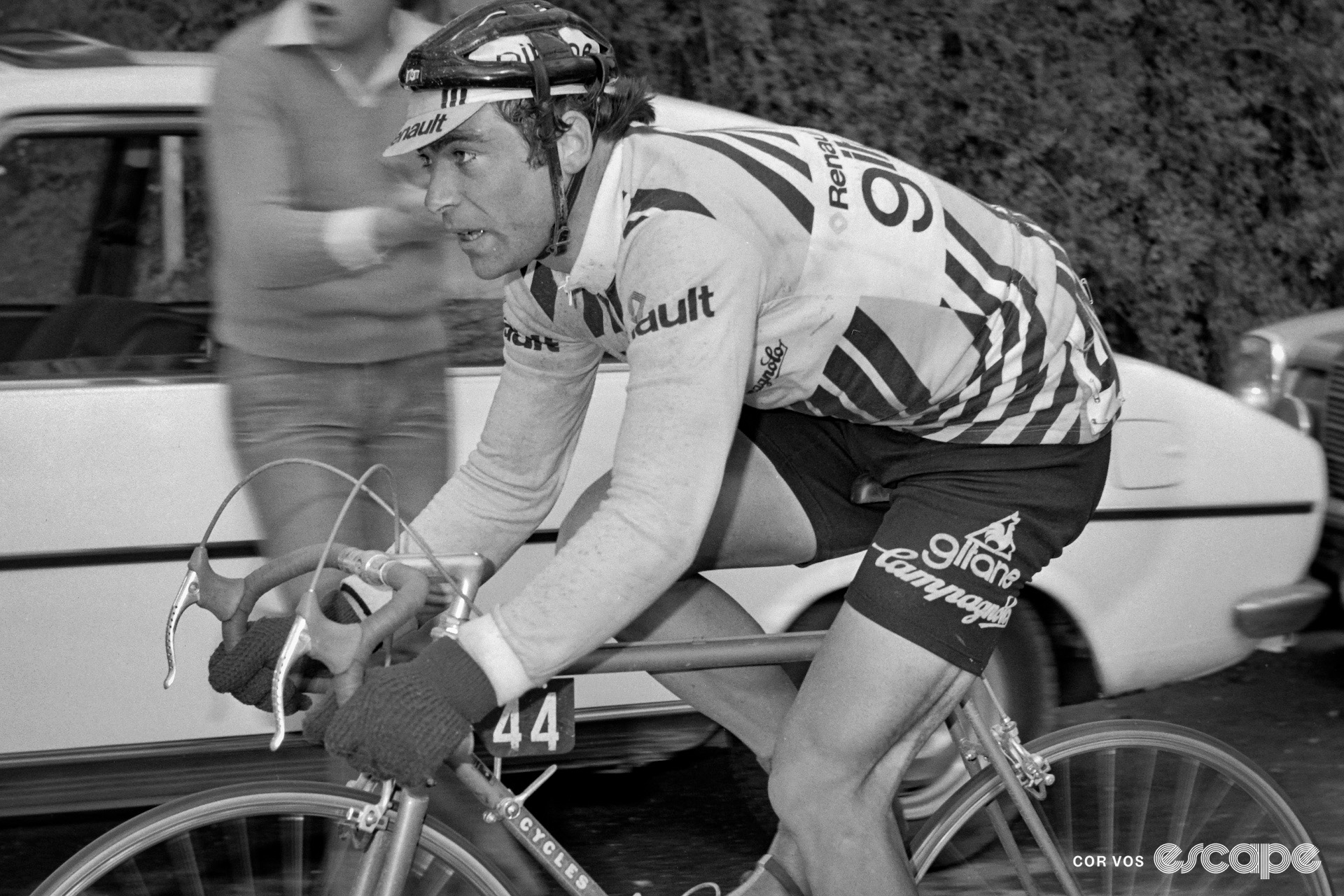
So on the weekend that winter storms have chilled northern Europe to the bone, join us in reliving one of the most infamous and memorable editions of Liège-Bastogne-Liège, now fondly nicknamed ‘Neige-Bastogne-Neige’. It is April 20th 1980, the last weekend of the Ardennes races, and the dramatic curtain call of another Classics season …
Setting the stage:
- 1980 was firmly in the golden era of Bernard Hinault, or ‘The Badger’, the Breton who was known for his aggressive, punchy and versatile skillset. Like many of the top riders of today, the Frenchman was a dominant GC rider who also excelled in one-day races, and who spread his results throughout the season.
- The Spring Classics of 1980 saw plenty of big names climb the podium, starting with first-time Monument winner Pierino Gavazzi at Milan-Sanremo ahead of compatriot Giuseppe Saronni at the start of a very good spring for Italy. The Tour of Flanders went to Belgian workhorse Michel Pollentier, and Francesco Moser took the disappointment of second place – the closest he would ever come to winning in Flanders in nine attempts – into the next weekend where the Classics legend scored his third consecutive Paris-Roubaix title. Once in the Ardennes, world champion Jan Raas extended his Amstel Gold winning streak to four, then Saronni picked things back up for the Italians with victory atop the Mur de Huy in a rare two-man break, Hinault bringing home the next group for third.
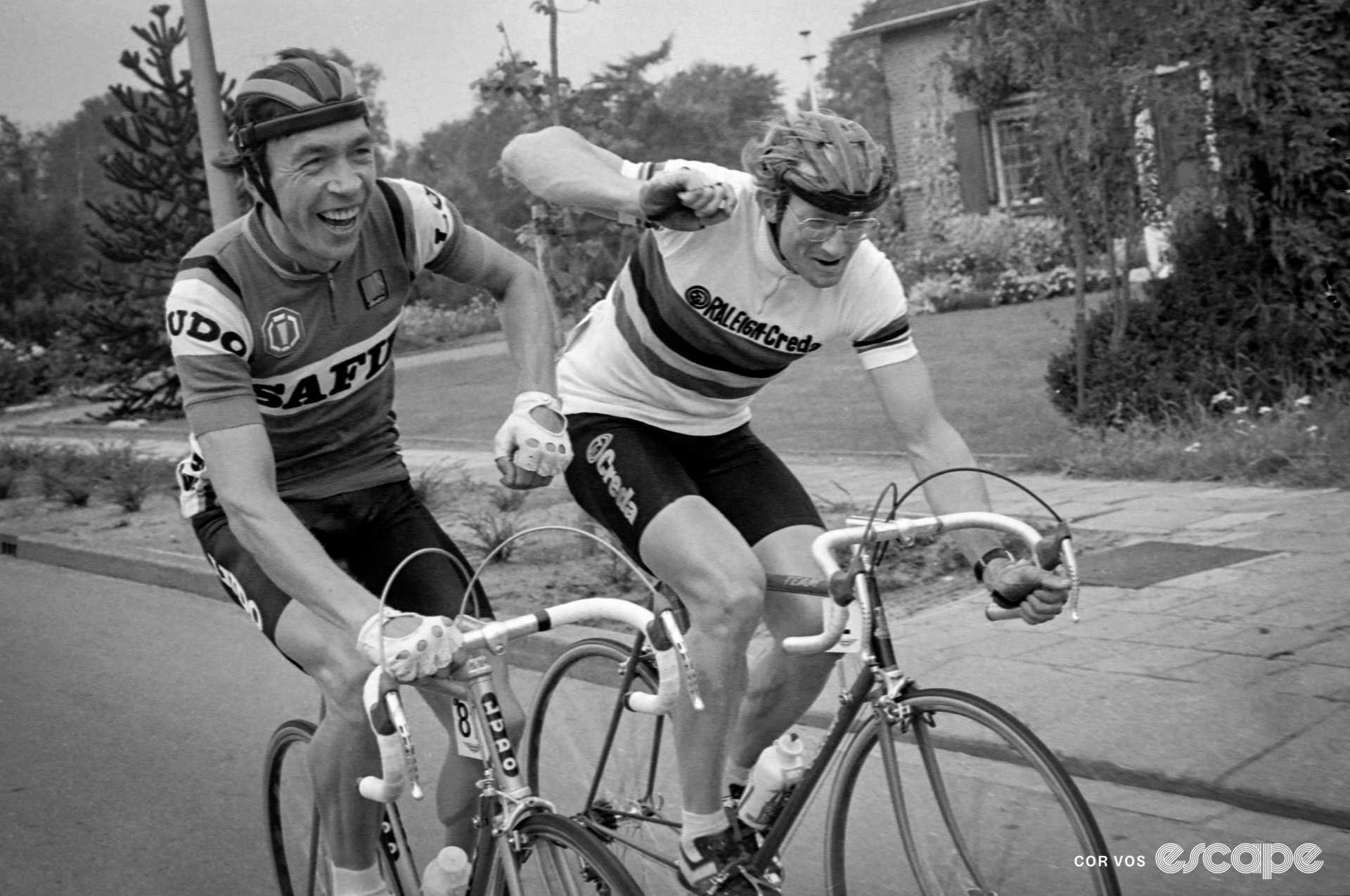
- Reigning Liège-Bastogne-Liège winner Dietrich Thurau was also a some-time GC contender and track rider, finishing in the top five of each Grand Tour by the end of his career and racking up 13 stage wins by 1980. The German, who was just five days older than Hinault, had won the 1979 edition with a solo move that saw him finish 55 seconds ahead of a bunch led home by his French rival. After retiring in 1988, Thurau would go on to admit during a newspaper interview the following year that he’d doped throughout his career – it is worth noting that this was in a period during which a found-out doper might only incur a fine, time penalty, relegation and suspended one-month ban, as Thurau was handed retroactively for the 1987 Tour. Not so for his son Björg who had nine years of results expunged from 2010 up to his retirement on being found guilty of numerous doping offences in 2021.
- Also on the start line was Paul Wellens, uncle of UAE Team Emirates rider Tim, who’d enjoyed a couple of very good years in the latter half of the ‘70s with wins in the Basque Country, Tour de France and the overall Tour de Suisse in 1978.
- 1979 had been Hinault’s most successful season to date – and of his career, as it would turn out – during which he’d secured his second consecutive Tour de France title with seven stage wins along the way, no less than four of them individual time trials (adding up to a total of 168 km; there were also two TTTs that together covered a staggering 177 km). Earlier in ’79 season he’d finished seventh at Milan-Sanremo, eighth at Gent-Wevelgem, 11th at Paris-Roubaix and second at Liège, and he’d won La Flèche Wallonne and the Critérium du Dauphiné. He ended the season as it had begun with a handful more victories including his first (of two) Il Lombardia titles.
- It was a fairly quiet start to the 1980 season by comparison, building up to a minimal Classics campaign where he finished fifth, fourth and third at Amstel Gold, Paris-Roubaix and La Flèche Wallonne respectively.
How it happened:
- A British weather report might optimistically describe the conditions on 20th April 1980 as ‘unsettled’, when in actual fact, the weather on that particular Sunday was good for anything but racing a bicycle in minimal close-fitting clothing. Our video begins with the commentary: “A few days after a Flèche Wallonne contested in sunshine and pleasant spring conditions, now the 66th edition of Liège-Bastogne-Liège … is raced in incredible, Dantesque conditions.”
- Within an hour of attempting to race in what soon turned from heavy sleet to a blizzard of snow, 60 riders had clambered off their bikes, and after 70 km, commentator Luc Varenne said only 60 riders survived.
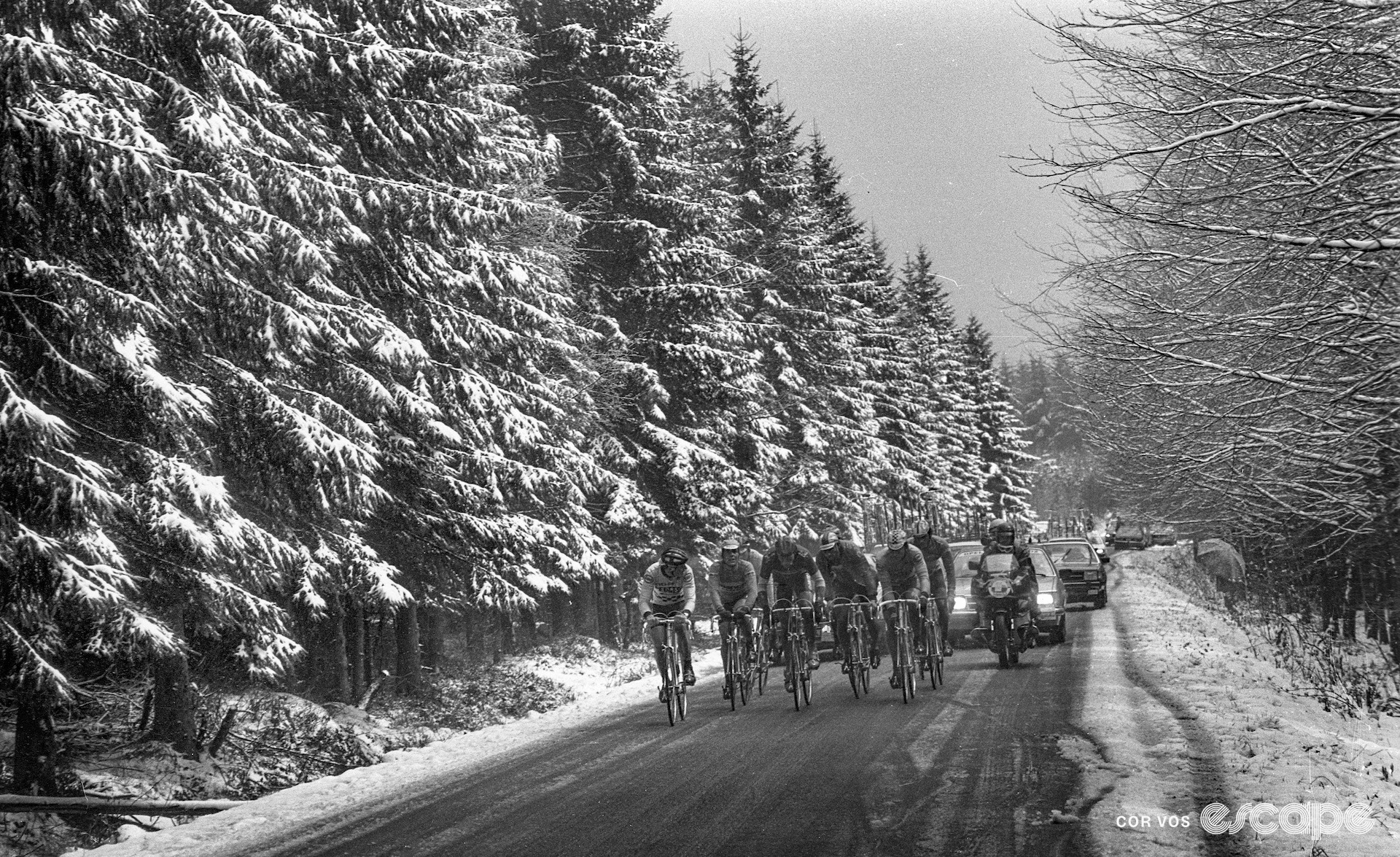
- Such was the forecast, that there are unconfirmed stories that some of the 174 registered starters retreated to their hotels after signing on and never turned a pedal in anger. Others gave up as the weather worsened, some simply turning around and riding back into Liège.
- The snow eased by the time the race reached Bastogne, but the bad weather was waiting for them as they turned back towards Liège.
- Of Hinault’s Renault-Gitane team, only Maurice Le Guilloux had survived to help his teammate into the last 100 km before giving in to the freezing conditions and seeking out a hot shower – Jean-René Bernaudeau, now the big boss at TotalEnergies, was another of his teammates, and one of many to abandon early in the first hour or so.
- Hinault himself had considered withdrawing despite feeling warm inside his waxed rain cape, but after his team suggested he disrobe to only mild protest, the Breton had a renewed motivation to reach Liège as quickly as possible. “I decided the only thing to do was ride as hard as I could to keep myself warm.”
- Leading the race – now down to just 21 riders – at around this point were Rudy Pevenage and Ludo Peeters, who had a little over two minutes on the peloton of survivors on the tough Stockeu climb.
- Hinault then took advantage of the gradients and launched up the same ascent, taking a small group with him, including Silvano Contini and Henk Lubberding.
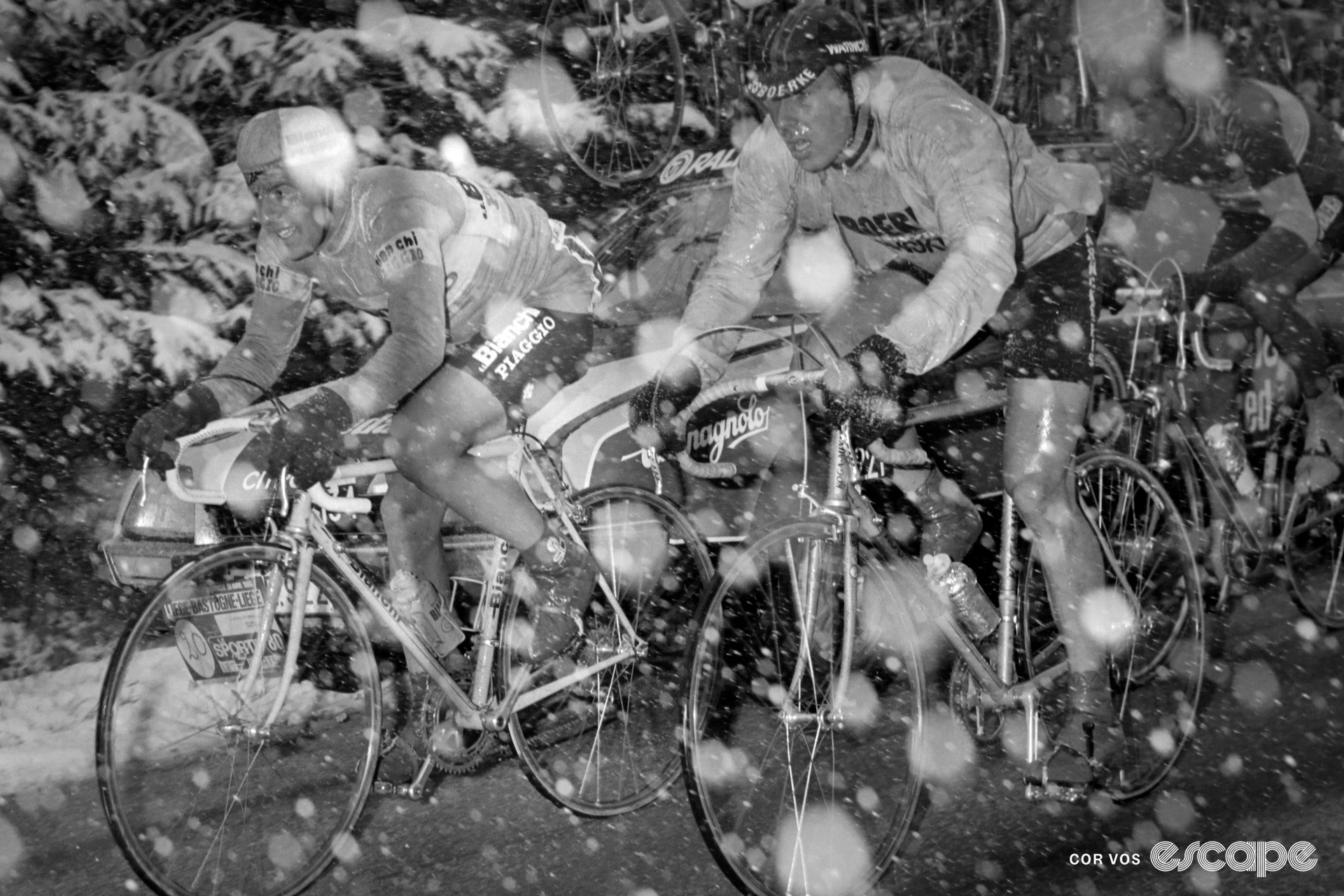
- After working his way up to the front by the Côte de la Haute-Levée, Hinault soon found he was solo almost by accident with 80 km to go, having left behind his short-lived company and passed the now-lonely early attacker Pevenage – the Belgian logged a DNF while his breakaway companion Peeters rallied to finish sixth.
- The Frenchman hadn’t intended to go solo from such a distance, but he later said he was never in doubt once he’d broken free, perhaps due to the abysmal weather that turned a tough day in the saddle into a festival of suffering, which rendered impossible any further heroics from his rivals.
- The weather ultimately cleared again as Hinault completed the last few kilometres of a most memorable Liège-Bastogne-Liège, and he was even joined by his shadow for the finale.
- Lined with fans spilling into the road, the finishing straight welcomed Hinault who had strength to do no more than lift one hand in salute. Almost ten minutes later, Hennie Kuiper – who had had a dramatic race himself that included losing almost a minute after getting tangled up in a crash with another rider – beat 22-year-old Ronny Claes in the sprint for second.
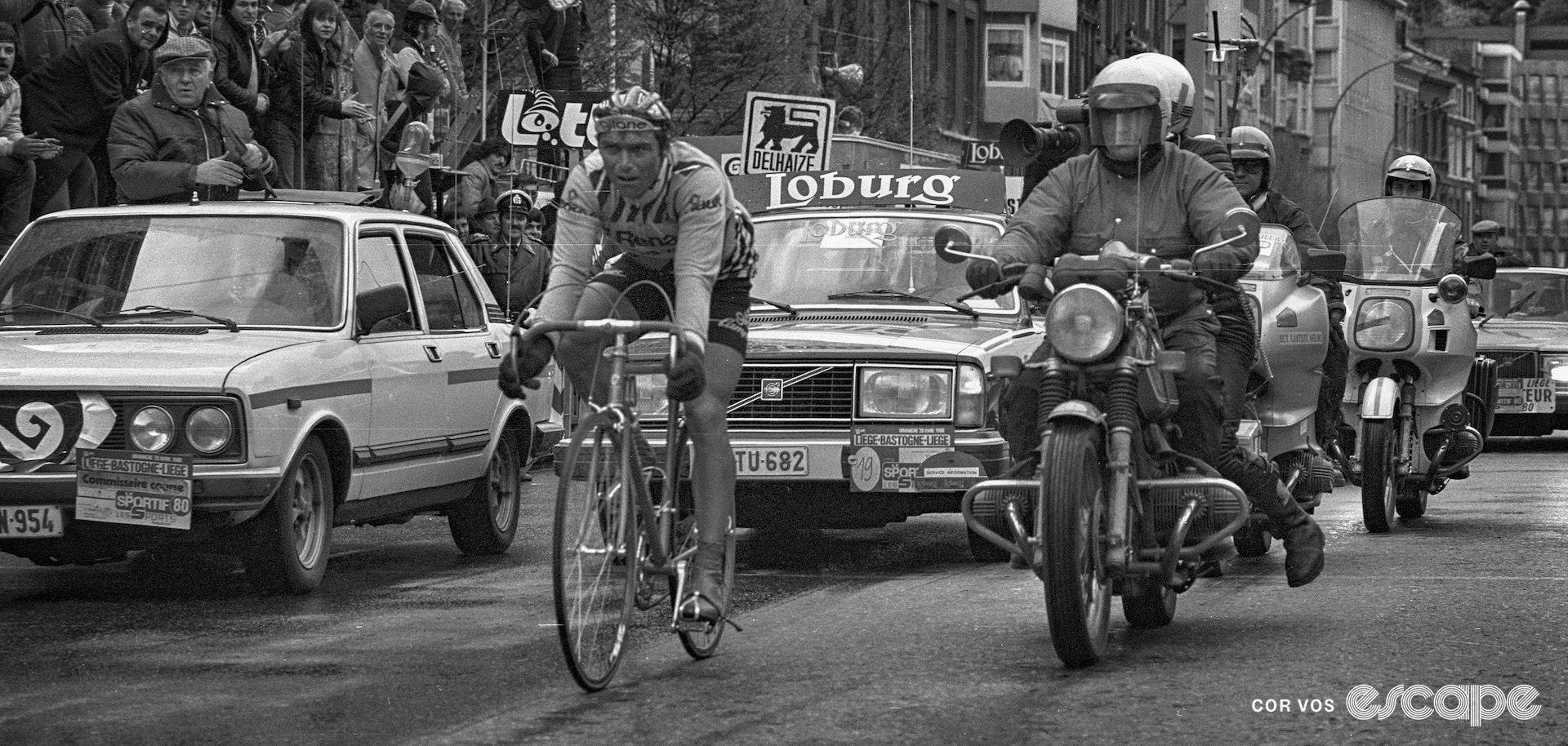
Top 10:
- Bernard Hinault (Renault-Gitane-Campagnolo) 7:01:42
- Hennie Kuiper (Peugeot-Esso-Michelin) +9:24
- Ronny Claes (Ijsboerke-Warncke Eis-Koga Miyata) “
- Fons De Wolf (Boule d’Or-Sunair-Colnago) +10:34
- Pierre Bazzo (La Redoute-Motobecane) “
- Ludo Peeters (Ijsboerke-Warncke Eis-Koga Miyata) “
- Herman Van Springel (Safir-Ludo) +12:05
- Guido Van Calster (Splendor-Admiral-TV Ekspres) +12:35
- Johan van der Velde (TI Raleigh-Creda) “
- Eddy Schepers (Daf Trucks-Lejeune-PZ) “
The 21st and last finisher was Jostein Wilmann (Puch-Sem-Campagnolo) at +27:00.
Brief analysis:
- Looking back from a much more safety-conscious and enlightened era, it is remarkable that the race was allowed to go ahead. But back then the sport was vaunted as a pastime driven more by an ability to out-suffer the next athlete than anything else like speed, tactics, power, etc. – you might think it still is. That said, ‘La Doyenne’ is still the Monument that most often experiences wintery conditions despite its relatively late position in the calendar, e.g. Wout Poels’ landmark win in 2016. Although it’s hard to forget Milan-Sanremo in 2013 when the peloton was swallowed up by a snowstorm in the early stages, resulting in an unusual mid-course bus ride before a reduced peloton raced on to the finish.
- Today's extreme weather protocol helps make racing a bit safer and more humane. The only downside of that is that the sport won’t have these kinds of epic moments going forward. There’s something about sports contested outdoors where weather becomes a critical factor in the mythmaking: think the NFL Ice Bowl, or the 2008 Champions League final, US golfers shivering through the cold at the 2010 Ryder Cup because their clothing sucked, the extreme heat at the 2014 Australian Open that melted water bottles on the court. All these events still loom large in memory because they were played in absolutely abysmal conditions and there’s something in us as fans that absolutely delights in that – in watching people try to excel through meteorological misery. Sometimes it’s kinda fun to do really stupid things in terrible weather. The issue is that it's hard to believe that the racers in these instances are truly able to make their own choices in that regard, and that’s what separates it from the average amateur going for a snowy mountain bike ride in -10°F. [Joe Lindsey]
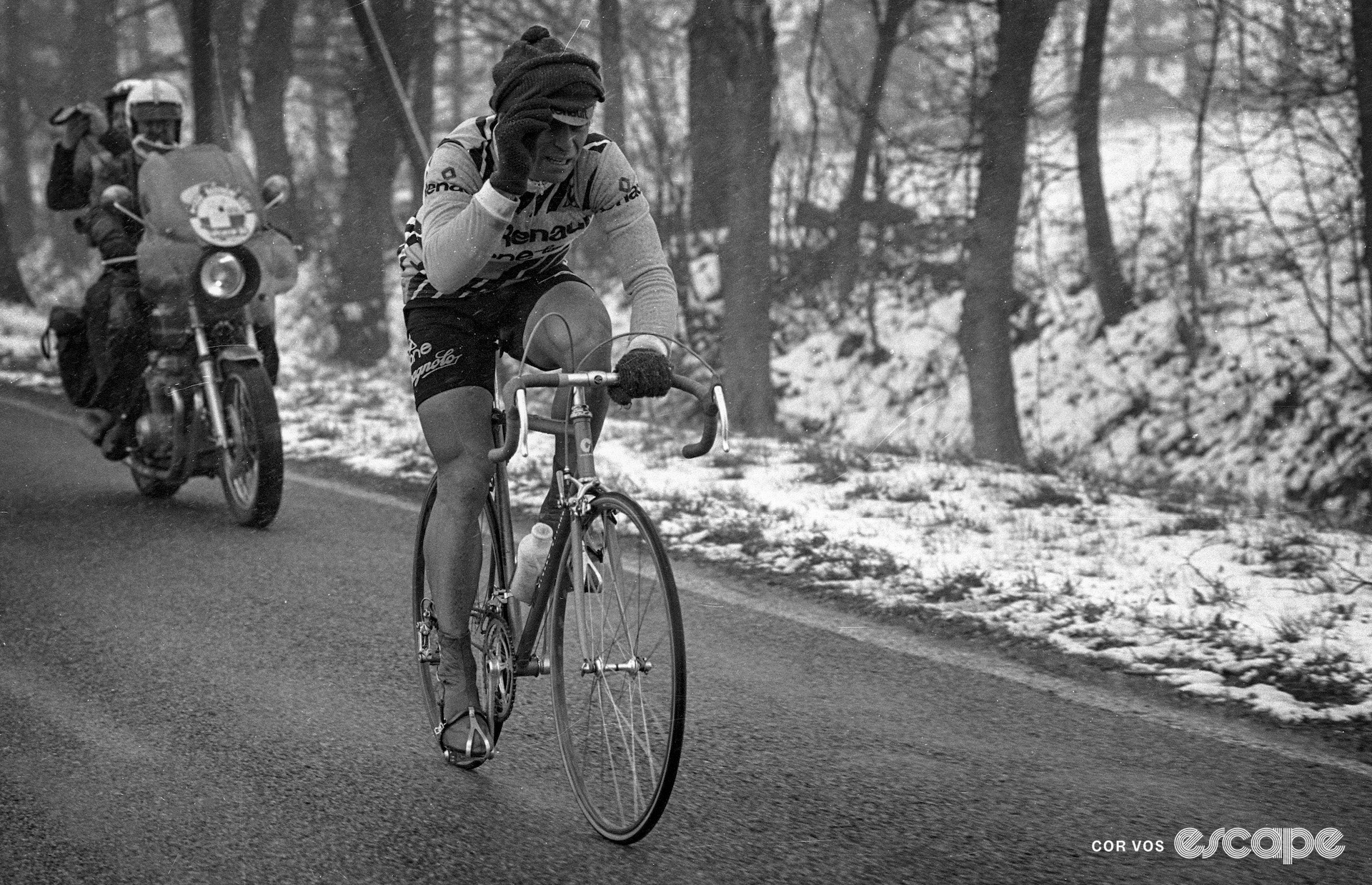
- On that note, the kit and equipment back then, or the clothing decisions made before the start, leave a lot to be desired. Sure, Hinault might have had a waxed rain cape for most of the race, not to mention some enormous gloves and a red woolly hat that looks every bit like he snatched it from the head of an innocent spectator, but with bare legs and even short-sleeved jerseys in some cases, it’s no wonder only 21 riders (12%) finished.
- There’s also a clear reminder of how far cycling has come in terms of fit and form. Joe points out that footage of the riders climbing among the snow-covered trees shows them “bobbing up and down on the pedals like pigeons.” Is that down to the gear ratios in use back then? Or a sign of the benefits of a decent bike fit, understanding of aerodynamics and efficiency, and time spent in the wind tunnel?
What happened next?
- In the immediate aftermath, it apparently took several weeks for the feeling to return to all Hinault’s frostbitten fingers, but the damage was lasting, and the index and middle digits of his right hand would cause him discomfort for years to come.
- After the 1980 classics, Hinault turned his attention to an attempt at the Triple Crown – Giro, Tour and World titles – which meant a debut appearance at the Giro d’Italia, via overall victory at Tour de Romandie. That first Giro was actually pretty light on stage results for Hinault who had to wait until stage 14 to take his only win, although he had already worn the leader’s jersey for a couple of days after finishing runner-up in the stage 5 ITT. Hinault then took back the race lead on stage 20 (of 22 plus a prologue) and held it until the finale in Milan. He was forced to concede what might have been a third-consecutive yellow jersey that summer, though, succumbing to a knee injury picked up earlier in the race and handing over the race lead to key rival Joop Zoetemelk. The Triple Crown too was out the window, but even so, Hinault wrapped up the year as intended at the World Championships.
- Like so many before and after him, the Badger was immune to the so-called Curse of the Rainbow Bands as 1981 got underway. He finally toppled Jan Raas from the Dutchman’s Amstel Gold dominance in early April, then begrudgingly returned to the cobbles of Roubaix, only to snatch the cobblestone trophy out from under the noses of Francesco Moser and Roger De Vlaeminck in a six-man sprint. 1981 also saw Hinault return to the top at the Tour, this time winning over Lucien van Impe by almost 15 minutes.
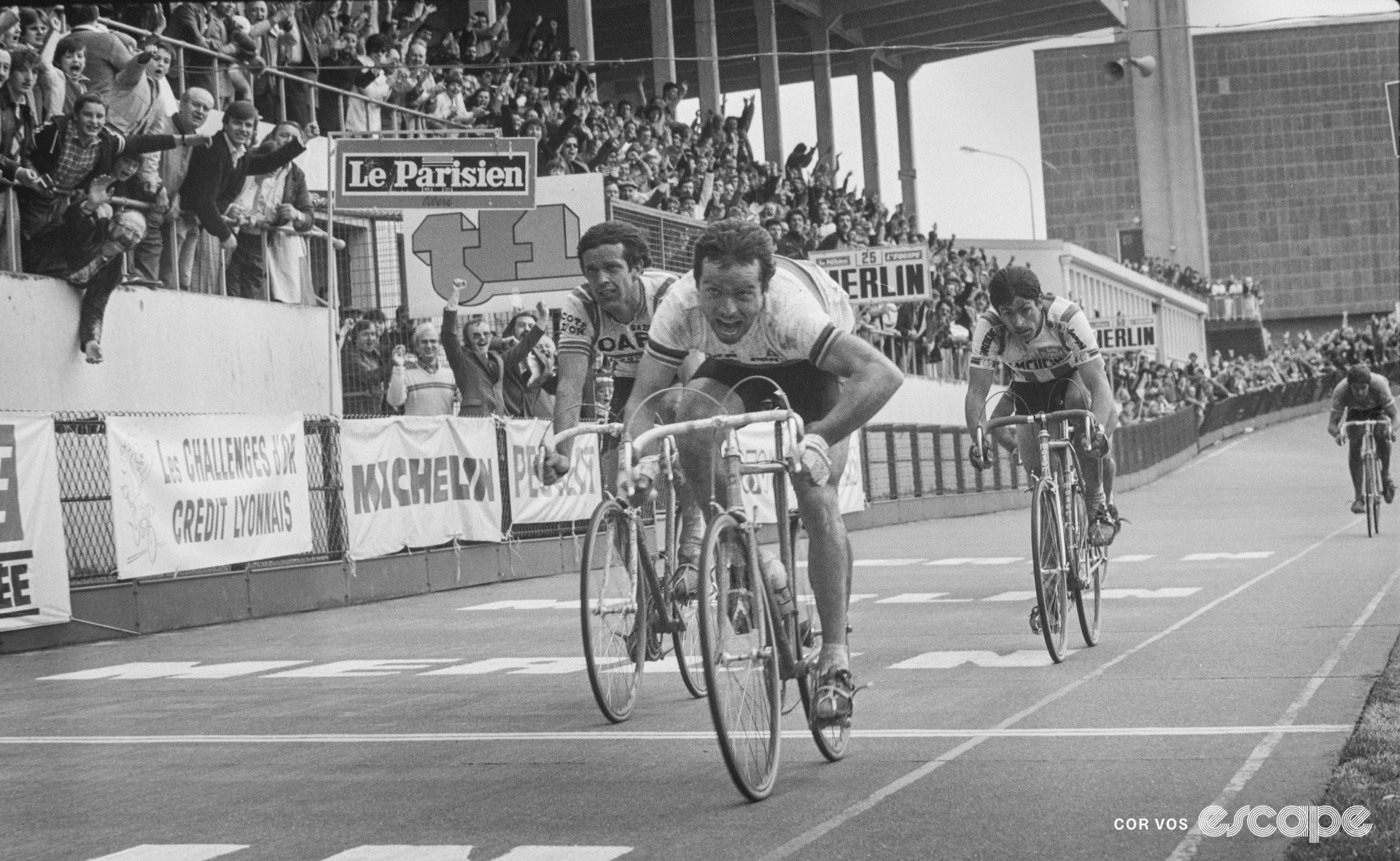
- Hinault would rack up 146 wins in his career – 82 more after Liège 1980 – continuing to score at the highest level until his final year pro in 1986, including at the Tour de France where he won three stages and was only kept from taking a record sixth yellow jersey by his young La Vie Claire teammate Greg Lemond, to whom he had pledged his support prior to the race, but that’s a whole other story ...
Did we do a good job with this story?




